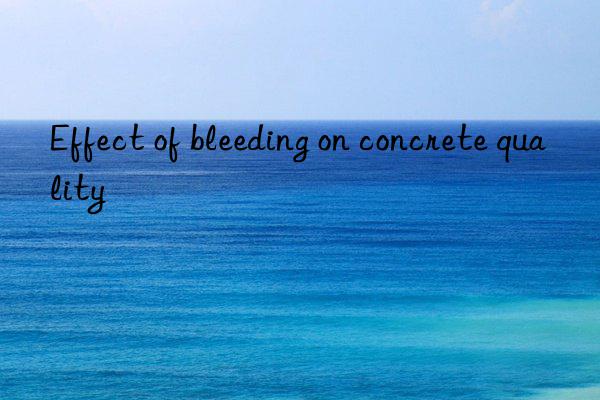
Bleeding is harmless if it occurs at the same rate as the evaporation rate of water on the surface of the concrete. The moisture content of concrete is very necessary to ensure workability and improve constructability. If excess water can overflow through bleeding after pouring, the water-cement ratio can be reduced and the density of concrete can be improved. Early bleeding when the concrete is still in the plastic stage does no harm to the concrete. At this time, the concrete is still in the settling and vibrating stage. If the concrete has lost its plasticity and begins to set initially, the bleeding at this time will have a negative impact on the performance of the concrete.
The total amount of bleeding is closely related to the concrete mix ratio, especially the water consumption and fine particle content (cement, fly ash and other mineral additives, fine aggregate, etc.). The greater the water consumption, the greater the amount of bleeding; the greater the content of fine particles, the smaller the amount of bleeding. The amount of bleeding is also related to the thickness of the concrete pouring. The thicker the thickness, the more bleeding.
Normally, bleeding occurs evenly across the entire concrete surface. However, in some special cases, if there are vertical bleeding channels inside the concrete, the water will migrate upward very quickly in these channels, which may bring out some fine particles, leaving "worm eyes" inside and forming on the surface. "Sand bar". These drainage channels are usually caused by excessive bleeding. The bleeding channel leaves an open path on the surface of the concrete, allowing corrosive substances such as deicing salts to easily enter the interior of the concrete, causing the concrete to suffer from corrosion of steel bars, reduced durability and other diseases.
During the bleeding process, water may be retained by flat or flaky aggregates and steel bars. When water accumulates under these aggregates or steel bars, so-called "endocrine water" will be formed. This endogenous water may also eventually exude from the surface, forming pooling water on the concrete surface. The endocrine water trapped under the aggregate or steel bars will increase the local water-cement ratio, affecting the bonding strength of the cement stone, aggregates and steel bars, forming a fragile joint surface that will be damaged by factors such as hydration heat and dry shrinkage. Under the action of the tensile stress caused, micro-cracking is prone to occur. During the service of the structure, affected by the load, these micro-cracks will gradually intensify, directly affecting the safety and durability of the concrete structure.
Surface bleeding will reduce the density and friction resistance of the concrete surface. If the bleeding water on the surface is smoothed and polished before it has completely evaporated, the bleeding water will be pressed back to the surface of the concrete, increasing the water-cement ratio of the surface layer, reducing the strength of the surface layer, easily inducing plastic cracking, dry shrinkage cracking, and affecting the strength of the concrete. Durability, and may also cause bubbles, peeling, sanding and other phenomena on the concrete surface. Therefore, the concrete surface must be roughly smoothed before bleeding occurs, and then polished after the bleeding has completely evaporated.
Bleeding will also cause a large amount of cement slurry to accumulate at the horizontal construction joints, and a low-strength bonding layer will appear at the construction joints.
</p

 微信扫一扫打赏
微信扫一扫打赏

